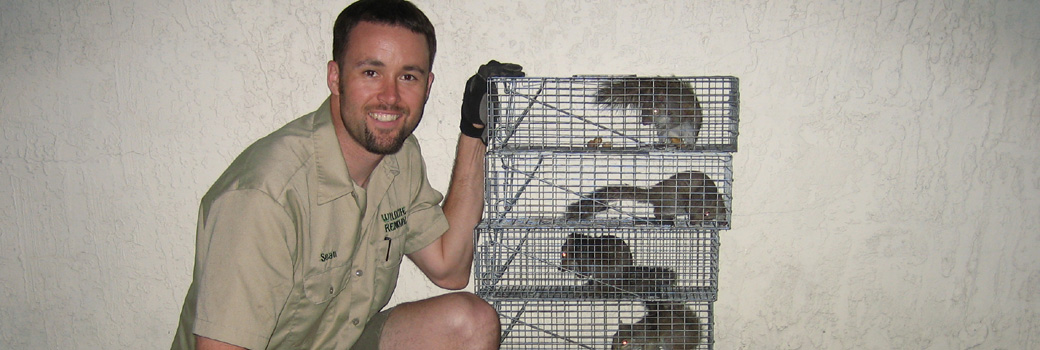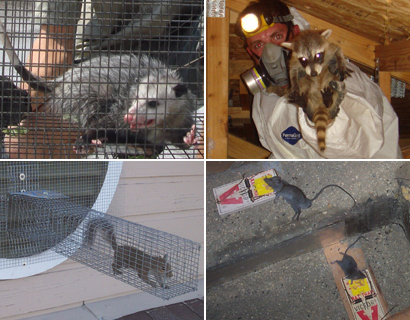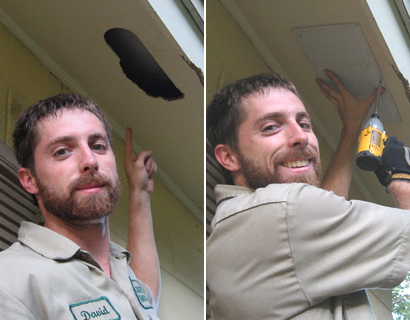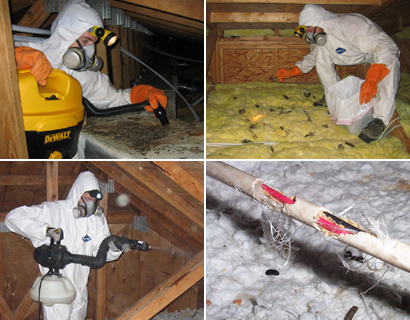- How We Solve Massachusetts Wildlife Problems
How We Solve Middlesex County Wildlife Problems
INSPECTION: Once on site, we will perform a full inspection of your home and property. This allows us to use the correct strategy and traps. If the animals are in an attic, a full building inspection is crucial, including the following:
- All ground-level areas, such as piper or A/C line entry & exit areas, A/C chase bottoms, ground-level vents, etc.
- All mid-level areas, such as dryer vents, siding gaps, first floor eaves or dormers, etc.
- We inspect the entire roof, including all plumbing stacks, ridge caps, vents, and other potential gaps or holes.
- We also inspect inside your attic, to identify animals and damage they have caused.
- If the animals are outside, we notice many subtle clues that will assist us in a successful strategy.
TRAPPING, EXCLUSION, REMOVAL: Once we understand what animal species we are dealing with, and the problem, we use the most effective means of removing the animals. We use dozens of different types of traps.
- Trapping - If trapping the animal(s) in live cage traps, trap type, set, and location are crucial to success.
- Exclusion - Oftentimes, we are able to simply set one-way doors or other exclusion devices that allow the animals inside a building to safely exit, but never get back inside.
- Removal By Hand - Sometimes we actually remove animals by hand, or with special tools like snare poles.
- The Law - In all cases, we obey state and local laws regarding wildlife, but aim to take the most humane approach.
ENTRY HOLE REPAIRS: Repairs are a crucial step in the wildlife removal process. In many cases, such as bat or rodent control, the job cannot be performed without detailed repairs, and in all cases, sealing the entry holes shut ensures that no future wildlife will ever enter your home.
- 100% of the entry holes must be found, and sealed shut, or the job is not complete.
- Our repairs are professional contractor grade, look good, and when applicable we use steel, which rodents such as rats or squirrels are unable to chew through.
- We give a written guarantee on our repairs against any future animal entry.
ATTIC DECONTAMINATION SERVICES: It may be desirable to clean your attic after we've removed the animals. They can leave behind large amounts of droppings, urine, hair, oils, food, nesting material, and so on. These remnants can attract insects like cockroaches, and the scent left behind can encourage new animals to chew their way into your house. You might experience odor problems from the waste. It's possible that mold will grow on waste areas.
- We remove or vacuum all droppings, or remove all the soiled insulation.
- We fog the attic with a special enzyme-based cleaner that destroys any organic matter and deodorizes the space.
- We repair damage, such as ductwork, electrical wires, pipes, insulation, and more.
The eastern MA area is home to several pest species. We frequently deal with skunks, possums, groundhogs and raccoons, but we most commonly handle squirrels in the attic and bats in houses. These animals, and birds lik pigeons seem to linger in places where they have found food in hopes of finding some next time they are hungry. If they aren't shooed away over a period of days or weeks, they may start to nest in the trees or on the roof of your home. They can cause damage to your property and their droppings can be difficult to clean in large amounts. Our team is here to help! We answer our phones 24 hours a day, 7 days a week to better service your Middlesex County Wildlife needs. We service the following cities: Acton, Ashby, Ashland, Ayer, Bedford, Belmont, Boxborough, Burlington, Concord, Dracut, Dunstable, Groton, Holliston, Hopkinton, Hudson, Lexington, Lincoln, Littleton, Maynard, North Reading, Pepperell, Reading, Sherborn, Shirley, Stoneham, Stow, Sudbury, Tewksbury, Townsend, Tyngsborough, Wakefield, Wayland, Westford, Weston, Wilmington, Winchester, Lowell, Cambridge, Newton, Somerville, Framingham, Waltham, Malden, Medford, Arlington, Everett, Billerica, Woburn, Chelmsford, and Natick. We also service the following counites: Hillsborough County, Essex County, Suffolk County, Norfolk County, and Worcester County.
Other Middlesex County animal pest control topics:
How to Get Rid of Snakes
How to Remove Pigeons From an Attic
How to Trap Moles
How to Repel Groundhogs
To learn more about our services, visit the Middlesex County wildlife control home page.
This month's wildlife how-to article: How To Repair Different Types Of Wildlife Damage And Entry Holes
How To Repair Different Types Of Wildlife Damage And Entry Holes
We all want wild animals to thrive but not at the cost of them living in your house. For this we take many steps and try not to kill them. These critters are a long term nuisance and you will not be able to keep them away so easily just by using traps or repellants or methods of preventions, some permanent measures have to be taken for staying away from these un-wanted invaders. The only permanent solution after removing them from your yard is repairing the house so that you stop their entry.

If they are inside your house then there has to be a way, a hole or a crack they have used to enter. While repairing the house specifically for the wild animals, the point has to be made clear that the damage is done by the animals only or else money waste, time waste and they still have an entry. Locate the damage first and check whether the animal is still inside or not. If the animal is inside then you need to find out what animal it is, as all animals do come out sometime in search of food. You need to study about that particular critter’s habits. Here are some of the most common places these critters use to enter the house:
- Hole in the wall: The exterior wall of the house is the most important portion of the structure. If you find a small hole, it could be sealed off maybe with some filling product like cement and you might have to use some bricks for a bigger one. Look for burrows near the wall and check inside the basement, there could be a hidden passage. Repairing a wall needs more precaution as the structure depends on it so it might be a good idea to get professional assistance if the damage is more.
- The roof: Another most vulnerable spot for the invaders to invade as usually roof goes neglected. But if you find trace of animal in your attic, checking the roof thoroughly is required. For vents and chimney outlets it is better to cover them with mesh wire. One more thing needs to be checked while repairing the roof, is nearby trees. If you find any branches over the roof then it is advisable to cut those branches off. After performing all these repairs still it’s recommended to keep the surroundings less useful for the rodents. Like garbage bins to be secured and no food items lying around.





